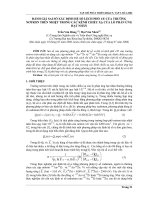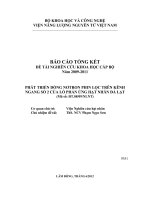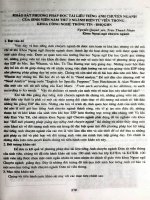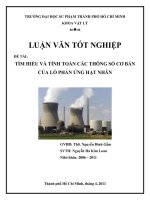Tài liệu tiếng anh Thủy nhiệt của lò phản ứng hạt nhân
Bạn đang xem bản rút gọn của tài liệu. Xem và tải ngay bản đầy đủ của tài liệu tại đây (3.66 MB, 418 trang )
THERMAL-HYDRAULIC IN
NUCLEAR REACTOR
GS. Trần Đại Phúc
1
THERMAL-HYDRAULIC IN
NUCLEAR REACTOR
Summary
I. Introduction
I.1. Safety Functions & Requirements
I.2. Basis of thermal-hydraulic core analysis
I.3. Constraints of the thermal-hydraulic core design
II. Energy from nuclear fission
III. Fission yield
IV. Decay heat
V. Spatial distribution of the heat sources
VI. Coolant flow and heat transfer in fuel rod assembly
VII. Enthalpy distribution in heated channel
VIII. Temperature distribution in channel in single phase
IX. Heat conduction in fuel assembly
2
THERMAL-HYDRAULIC IN
NUCLEAR REACTOR
Summary
X. Axial temperature distribution in fuel rods
XI. Void fraction in boiling channels
XI.1. Homogeneous Equilibrium Model (HEM)
XI.2. Drift-flux model
XI.3. Sub-cooled boiling region
XII. Heat transfer to coolant
XII.1. Single phase
XIII. Two-Phase flow
XIV. Pressure drops
XIV.1. Single-phase flows
a) The Darcy Weisbach equation
b) The Moody diagram
XIV.2. Two-phase flows
3
THERMAL-HYDRAULIC IN
NUCLEAR REACTOR
Summary
XV. Critical Heat Flux (CHF)
XV.1. Departure from Nucleate Boiling (DNB)
XV.2. Dry-out
XV.3. Protection against boiling crisis
A. Fuel temperature
B. Reactor core coolant mass flow rate
C. Hydro-dynamic stability of the reactor core
D.Technology of the DNBR or Critical Heat Flux ratio and
Mixing effect
D.1.Technology of the DNBR
a) Critical Heat Flux (CHF) – Correlation
E)Definition of the DNBR
F) Mixing effect between sub-channels
4
THERMAL-HYDRAULIC IN
NUCLEAR REACTOR
Summary
G) Uncertanties relative to the manufacturing parameters
H) Effect of the eccentricity of the fuel pellets and the ovality
of the cladding on the CHF.
I) Effect of the manufacturing tolerances of the spacer grids
on CHF
J) Effect of the fuel rod bowing in the reactor on the CHF
k)Correlation between the heat transfer and the void
coefficient to the radial distribution of the nuclear power
l)E. Hydro-dynamic instability
m)F. Defect of distribution of the rate at pressure-vessel inlet
n)G. Pressure drops in the pressure-vessel
o)H. Hydraulic forces
p)I. Hydraulic Dimensioning of the internal components
5
THERMAL-HYDRAULIC IN
NUCLEAR REACTOR
Summary
J. Thermal effects during the normal transients.
K. Uncertainties
a) Statistical approach
b) Deterministic approach
c) Uncertainties relative to computer code and mixing
coefficient
d) Justification of the statistic combination of the
uncertainties.
e) Uncertainties relative to the manufacturing tolerances
f) Uncertainty relative to the design computer code
g) Uncertainty of the transient conditions versus the steady
state conditions
L. Temperatures of the fuel pellet and the cladding
6
THERMAL-HYDRAULIC IN
NUCLEAR REACTOR
Summary
M. Hydraulic
a) Uncertainties related to the pressure-drops in the reactor
core and in the pressure-vessel
b) Uncertainties due to the defect of the repartition of the
inlet mass flow rate
c) Uncertainties relative to the mass flow rate
d) Uncertainties relative to the hydraulic forces
e) Uncertainties relative to the hydraulic dimensioning of the
internal components
N. Methods of analysis and study data
N.1. Methods utilized to analyse the transients
O. Hot channel factors
XVI.1. Radial power distribution
7
THERMAL-HYDRAULIC IN
NUCLEAR REACTOR
Summary
XVI.2. Axial power distribution
XVI.3. Heat transfer in nuclear fuel rods bundles
a)Laminar Flow
b) Single-Phase Turbulent Flow
c) Nucleate Boiling Flow
d) Boiling Crisis
e)Quenching in Rod Bundles
f) Steam and water cross-flows
g) Ballooning and grid effects
h) Cold rod effects
XVI.4. Limitations of power distribution
XVI.5. Reactivity coefficients
XVI.6 Reactivity control
a) Safety requirements
8
THERMAL-HYDRAULIC IN
NUCLEAR REACTOR
Summary
b) Functional criteria
c) Design requirements
d) Tests
e) Design basis
f) The maximal control insertion of the reactivity
g) Shutdown margin
h) Sub-criticality
i)Description of the functional aspects of the design of the
systems
j)The command system of the control rods clusters
k) Chemical & Volume Control System (CVCS) & Emergency
Boration System (EBS)
l) Emergency Core Coolant System (ECCS)
9
THERMAL-HYDRAULIC IN
NUCLEAR REACTOR
Summary
n) Evaluation of the design
XVI.6. Fuel temperature coefficient (Doppler effect)
XVI.7. Moderator coefficient
XVI.7a. Density moderator coefficient
XVI.7b. Void moderator coefficient
XVI.7c. Heat flux limitations
XVI.7.d. The behaviour of the DNB correlations
XVI.7e. Requirements relative to the instrumentation
XVI.7.f. Operations at high linear power
XVI.7.g. Other criterion
XVIII. The corresponding core protection channels
XVIII.1. Limiting conditions of operation
XVIII.2. PWR nuclear instrumentation
10
THERMAL-HYDRAULIC IN
NUCLEAR REACTOR
Summary
A. Ex-core instrumentation
B. In-core instrumentation
C. Aeroball system for monitoring power distribution in the
reactor core.
XIX. Protection chains ΔTe & ΔTOP
XIX.1.Steady state ΔI = 0
XIX..2.Transient conditions
XIX.3. Instrumentation & setting errors
XIX.4. Taken into account of the unbalance of the axial power
XIX.5. Mass flow reductions
A.Thermal aspect
B. Neutron aspects
11
1. Shape of the neutron flux
a) Radial flux distribution:
THERMAL-HYDRAULIC IN
NUCLEAR REACTOR
Summary
b) Axial neutron flux distribution.
c) The Xenon effect
XXI. Computer codes in Nuclear Reactor Thermal-Hydraulics
XXII. Hydraulic loading in reactor core
XXII.1. Recall laminar flow & turbulent flow
XXII.2. Vortex-Shedding Issues
XXII.3. Basic Theory
XXII.4. Acoustic Resonance Issue due to Vortex Shedding
XXII.5. Acoustic Resonances of the Inner Channel Due to
Pump Blades Pass
XXII.6. Fluid-Elastic Instability
XXII.7. Discussion of Connor’s Equation Connor’s constant β
XXII.8. Fluid-elastic stability margin (FSM)
12
THERMAL-HYDRAULIC IN
NUCLEAR REACTOR
Summary
XXII.9.Turbulence Induced Vibration
XXII.10. Axial Flow Induced Vibration
XXII.11. Cross Flow Induced Vibrations
XXII.12. Wear Analysis in the Fuel Assembly
XXII.13. Archard theory of adhesive wear
XXII.14. Impact Wear
XXII.15. Sliding Wear
XXII.16. Fretting Wear
XXII.17. Turbulent flow inside a channel
XXII.18. Turbulent friction factor
XXII.19. Pressure drop in rod bundles
XXII.20. Friction Along Bare Rod Bundles
Laminar flow
13
THERMAL-HYDRAULIC IN
NUCLEAR REACTOR
Summary
XXII.22. Pressure drop at spacers
XXII.23. Lateral resistance across bare rods arrays
14
THERMAL-HYDRAULIC IN
NUCLEAR REACTOR
I. Introduction
An important aspect of nuclear reactor core analysis
involves the determination of the optimal coolant flow
distribution and pressure drop across the reactor core. On
the one hand, higher coolant flow rates will lead to better
heat transfer coefficients and higher Critical Heat Flux
(CHF) limits. On the other hand, higher flows rates will also
in large pressure drops across the reactor core, hence
larger required pumping powers and larger dynamic loads
on the core components. Thus, the role of the
hydrodynamic and thermal-hydraulic analysis is to find
proper operating conditions that assure both safe and
economical operation of the nuclear power plant.
15
THERMAL-HYDRAULIC IN
NUCLEAR REACTOR
This chapter presents methods to determine the distribution
of heat sources and temperatures in various components of
nuclear reactor. In safety analyses of nuclear power plants
the amount of heat generated in the reactor core must be
known in order to be able to calculate the temperature
distributions and thus, to determine the safety margins. Such
analyses have to be performed for all imaginable conditions,
including operation conditions, reactor startup and shutdown,
as well as for removal of the decay heat after reactor
shutdown. The first section presents the methods to predict
the heat sources in nuclear reactors at various conditions. The
following sections discuss the prediction of such parameters
as coolant enthalpy, fuel element temperature, void fraction,
pressure drop and the occurrence of the Critical Heat Flux
(CHF) in nuclear fuel assemblies
16
THERMAL-HYDRAULIC IN
NUCLEAR REACTOR
I.1. Safety Functions & Requirements
The safety functions guaranteed by the thermal-hydraulic
design are following:
Evacuation via coolant fluid the heat generated by the nuclear
fuel;
Containment of radioactive products (actinides and fission
products) inside the containment barrier.
Control of the reactivity of the reactor core: no effect on the
thermal-hydraulic design.
Evacuation of the heat generated by the nuclear fuel: The aim
of thermal-hydraulic design is to guarantee the evacuation
of the heat generated in the reactor core by the energy
transfer between the fuel
17
THERMAL-HYDRAULIC IN
NUCLEAR REACTOR
Rods to the coolant fluid in normal operation and incidental
conditions.
The thermal-hydraulic design is not under specific design
requirements.
However, the assured safety functions
requires the
application of a Quality Assurance programme on which the
main aim is to document and to control all associated
activities.
Preliminary tests: The basic hypothesis on scenarios adopted
in the safety analyses must be control during the first
physic tests of the reactor core. Some of those tests, for
example the measurements of the primary coolant rate or
the drop time of the control clusters, are performed
regularly. Other tests are performed in totality only on the
head of the train serial.
For the following units, only the necessary tests performed
to
18
guarantee that thermal-hydraulic characteristics of the
THERMAL-HYDRAULIC IN
NUCLEAR REACTOR
The primary coolant rate and the drop time of the control rod
clusters must be measured regularly.
The main aim of the thermal-hydraulic design is principally to
guarantee the heat transfer and the repartition of the heat
production in the reactor core, such as the evacuation of
the primary heat or of the safety injection system (belong
to each case) assures the respect of safety criteria.
I.2. Basis of thermal-hydraulic core analysis
The energy released in the reactor core by fission of enriched
uranium U235 and Plutonium 238 appears as kinetic energy
of fission reaction products and finally as heat generated in
the nuclear fuel elements. This heat must be removed from
the fuel and reactor and used via auxiliary systems19 to
convert steam-energy to produce electrical power.
THERMAL-HYDRAULIC IN
NUCLEAR REACTOR
I.3. Constraints of the thermal-hydraulic core design
The main aims of the core design are subject to several
important constraints.
The first important constraint is that the core temperatures
remain below the melting points of materials used in the
reactor core. This is particular important for the nuclear
fuel and the nuclear fuel rods cladding.
There are also limits on heat transfer are between the fuel
elements and coolant, since if this heat transfer rate
becomes too large, critical heat flux may be approached
leading to boiling transition. This, in turn, will result in a
rapid increase of the clad temperature of the fuel rod. 20
THERMAL-HYDRAULIC IN
NUCLEAR REACTOR
The coolant pressure drop across the core must be kept low to
minimize pumping requirements as well as hydraulic loads
(vibrations) to core components.
Above mentioned constraints must be analyzed over the core
live, for all the reactor core components, since as the power
distribution in the reactor changes due to fuel burn-up or
core management, the temperature distribution will
similarly change.
Furthermore, since the cross sections governing the neutron
physics of the reactor core are strongly temperature and
density dependent, there will be a strong coupling between
thermal-hydraulic and neutron behaviour of the reactor
core.
21
THERMAL-HYDRAULIC IN
NUCLEAR REACTOR
Thermal hydraulic considerations are important
when selecting overall plant charac-teristics.
Primary system temperature and pressure are
key characteristics related to both the coolant
selection and plant thermal performance. This
thermal performance is dictated by the bounds of
the maximum allowable primary coolant outlet
temperature
and the minimum achievable
condenser coolant inlet temperature. Because
this at-mospheric heat sink temperature is
relatively fixed, improved thermodynamic performance requires increased reactor coolant
outlet temperatures. Figure 2-1 illustrates the
22
relation among reactor plant temperatures for
a
typical PWR.
THERMAL-HYDRAULIC IN
NUCLEAR REACTOR
Bounds on the achievable primary outlet temperature depend
on the coolant type. For liquid metals, in contrast to water,
the saturated vapor pressure for a given temperature is
low, i.e., less than atmospheric pressure at outlet
temperatures of interest of 500° to 550°C.
For water-cooled reactors, on the other hand, high primary
outlet temperatures require correspondingly high system
pressures (7 to 15 MPa), which increases the stored energy
in the primary coolant and requires increased structural
piping and component wall thicknesses. Single-phase gas
coolants offer the potential for high outlet temperatures
without such inherently coupled high pressures.
23
THERMAL-HYDRAULIC IN
NUCLEAR REACTOR
For these reactors the system pressure is dictated by the
desired core heat transfer capabilities, as gas properties
that enter these heat transfer correlations are strongly
dependent on pressure. The resulting pressures are
moderate, i.e., 4 to 5 MPa, whereas achievable outlet
temperatures are high, i.e., 635° to 750°C. The nu-merical
value of the plant thermal efficiency depends on the
maximum temperature in the secondary or powergeneration system. This temperature is lower than the
reactor coolant outlet temperature owing to the
temperature difference needed to trans-fer heat between
the primary and secondary systems in the steam generator
or inter-mediate heat exchanger.
24
THERMAL-HYDRAULIC IN
NUCLEAR REACTOR
In the boiling water reactor a direct cycle is employed. The
reactor outlet temperature is therefore identical (neglecting
losses) to the inlet tem-perature to the turbine. This outlet
temperature is also limited to the saturation con-dition, as
BWRs do not operate under superheat conditions. In a
typical BWR, how-ever, the average outlet enthalpy
achieved corresponds to an average quality of 15%. The
PWR and BWR reactors achieve approximately equal
thermal efficiencies, as the turbine steam conditions are
comparable even though the primary system pressure and
temperature conditions significantly differ (Table 2-1). Note
that because of detailed differences in thermodynamic
cycles the example PWR plant achieves a slightly higher
25









